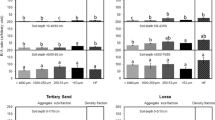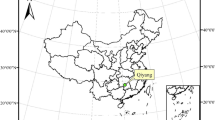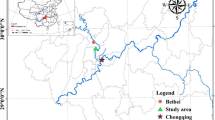Abstract
Alpine grassland soils on Qinghai-Tibet Plateau store approximately 33.5 Pg of organic carbon (C) at 0–0.75 m depth and play an important role in the global carbon cycle. We investigated soil organic C (SOC), water-soluble organic C (WSOC), easily oxidizable organic C (EOC), humic C fractions, aggregate-associated C, aggregate stability, and humic acid (HA) composition along an east-west transect across Qinghai-Tibet Plateau, and explored their spatial patterns and controlling factors. The contents of SOC, WSOC, EOC, humic C fractions and aggregate-associated C, the proportions of macro-aggregates (2-0.25) and micro-aggregates (0.25-0.053 mm), and the aggregate stability indices all increased in the order alpine desert < alpine steppe < alpine meadow. The alkyl C, O-alkyl C, and aliphatic C/aromatic C ratio of HA increased as alpine desert < alpine meadow < alpine steppe, and the trends were reverse for the aromatic C and HB/HI ratio. Mean annual precipitation and aboveground biomass were significantly correlated with the contents of SOC and its fractions, the proportions of macro- and micro-aggregates, and the aggregate stability indices along this transect. Among all these C fractions, SOC content and aggregate stability were more closely associated with humic C and silt and clay sized C in comparison with WSOC, EOC, and macro- and micro-aggregate C. The results suggested that alpine meadow soils containing higher SOC exhibited high soil aggregation and aggregate stability. Mean annual precipitation should be the main climate factor controlling the spatial patterns of SOC, soil aggregation, and aggregate stability in this region. The resistant and stable C fractions rather than labile C fractions are the major determinant of SOC stocks and aggregate stability.
Similar content being viewed by others
References
Abril A, Villagra P, Noe L (2009) Spatiotemporal heterogeneity of soil fertility in the Central Monte desert (Argentina). Journal of Arid Environments 73: 901–906. DOI: 10.1016/j.jaridenv.2009.04.019
ARDOQP (Agricultural Resources Division Office of Qinghai Province) (1997) Soil in Qinghain. China Agriculture Press, Beijing, China. (In Chinese)
Aranda V, Oyonarte C (2006) Characteristics of organic matter in soil surface horizons derived from calcareous and metamorphic rocks and different vegetation types from the Mediterranean high-mountains in SE Spain. European Journal of Soil Biology 42: 247–258. DOI: 10.1016/j.ejsobi.2006.03.001
Baumann F, He JS, Schmidt K, et al. (2009) Pedogenesis, permafrost, and soil moisture as controlling factors for soil nitrogen and carbon contents across the Tibetan Plateau. Global Change Biology 15: 3001–3017. DOI: 10.1111/j.1365-2486.2009.01953.x
Blair GJ, Lefroy RDB, Lisle L (1995) Soil carbon fractions based on their degree of oxidation, and the development of a carbon management index for agricultural systems. Australian Journal of Agricultural Research 46: 1459–1466. DOI: 10.1071/AR9951459
Boix-Fayos C, Calvo-Cases A, Imeson AC, et al. (1998) Spatial and short-term temporal variations in runoff, soil aggregation and other soil properties along a Mediterranean climatological gradient. Catena 33: 123–138. DOI: 10.1016/S0341-8162(98)00048-4
Bouajila A, Gallali T (2008) Soil organic carbon fractions and aggregate stability in carbonated and no carbonated soils in Tunisia. Journal of Agronomy 7: 127–137. DOI: 10.3923/ja.2008.127.137
Bronick CJ, Lal R (2005) Soil structure and management: a review. Geoderma 124: 3–22. DOI: 10.1016/j.geoderma. 2004.03.005
Bruun TB, Elberling B, Christensen BT (2010) Lability of soil organic carbon in tropical soils with different clay minerals. Soil Biology and Biochemistry 42: 888–895. DOI: 10.1016/j. soilbio.2010.01.009
Buyanovsky GA, Aslam M, Wagner GH (1994) Carbon turnover in soil physical fractions. Soil Science Society of American Journal 58: 1167–1173. DOI: 10.2136/sssaj1994.03615995005 800040023x
Cambardella CA, Elliott ET (1993) Carbon and nitrogen distribution in aggregates from cultivated and native grassland soils. Soil Science Society of America Journal 57: 1071–1076. DOI: 10.2136/sssaj1993.0361599500570004003 2x
Cao Y, Wang X, Lu X, et al. (2013) Soil organic carbon and nutrients along an alpine grassland transect across Northern Tibet. Journal of Mountain Science 10: 564–573. DOI: 10.1007/s11629-012-2431-5
Cerdà A (2000) Aggregate stability against water forces under different climates on agriculture land and scrubland in southern Bolivia. Soil and Tillage Research 57: 159–166. DOI: 10.1016/S0167-1987(00)00155-0
Chaney K, Swift RS (1984) The influence organic matter on aggregate stability in some British soils. Journal of Soil Science 35: 223–230
Chang X, Wang S, Cui S, et al. (2014) Alpine grassland soil organic carbon stock and its uncertainty in the three rivers source region of the Tibetan Plateau. PLoS ONE 9: e97140. DOI: 10.1371/journal.pone.0097140
Chen B, Zhang X, Tao J, et al. (2014a) The impact of climate change and anthropogenic activities on alpine grassland over the Qinghai-Tibet Plateau. Agricultural and Forest Meteorology 189-190: 11–18. DOI: 10.1016/j.agrformet.2014.01.002
Chen H, Hou R, Gong Y, et al. (2009) Effects of 11 years of conservation tillage on soil organic matter fractions in wheat monoculture in Loess Plateau of China. Soil and Tillage Research 106: 85–94. DOI: 10.1016/j.still.2009.09.009
Chen Y, Day SD, Wick AF, et al. (2014b) Influence of urban land development and subsequent soil rehabilitation on soil aggregates, carbon, and hydraulic conductivity. Science of the Total Environment 494-495: 329–336. DOI: 10.1016/j.scitotenv.2014.06.099
Cheng M, Xiang Y, Xue Z, et al. (2015) Soil aggregation and intra-aggregate carbon fractions in relation to vegetation succession on the Loess Plateau, China. Catena 124: 77–84. DOI: 10.1016/j.catena.2014.09.006
Conte P, Spaccini R, Piccolo A (2004) State of the art of CPMAS 13C-NMR spectroscopy applied to natural organic matter. Progress in Nuclear Magnetic Resonance Spectroscopy 44: 215–223. DOI: 10.1016/j.pnmrs.2004.02.002
Degens BP, Shipper LA, Sparling GP, et al. (2000) Decrease in organic C reserves in soils can reduce the catabolic diversity of soil microbial communities. Soil Biology and Biochemistry 32: 189–196. DOI: 10.1016/S0038-0717(99)00141-8
Doetterl S, Stevens A, Six J, et al. (2015) Soil carbon storage controlled by interactions between geochemistry and climate. Nature Geoscience 8: 781–783. DOI: 10.1038/NGE02516
Fan R, Liang A, Yang X, et al. (2010) Effects of tillage on soil aggregates in black soils in Northeast China. Scientia Agricultura Sinica 43: 3767–3775. (In Chinese)
Grinhut T, Hertkorn N, Schmitt-Kopplin P, et al. (2011) Mechanisms of humic acids degradation by white rot fungi explored using 1H NMR spectroscopy and FTICR mass spectrometry. Environmental Science and Technology 45: 2748–2754. DOI: 10.1021/es1036139
Gupta Choudhury S, Srivastava S, Singh R, et al. (2014) Tillage and residue management effects on soil aggregation, organic carbon dynamics and yield attribute in rice-wheat cropping system under reclaimed sodic soil. Soil and Tillage Research 136: 76–83. DOI: 10.1016/j.still.2013.10.001
Haynes RJ (2000) Labile organic matter as an indicator of organic matter quality in arable and pastoral soils in New Zealand. Soil Biology and Biochemistry 32: 211–219
Huang Z, Xu Z, Chen C, et al. (2008) Changes in soil carbon during the establishment of a hardwood plantation in subtropical Australia. Forest Ecology and Management 254: 46–55. DOI: 10.1016/j.foreco.2007.07.021
ISSS (International Society of Soil Science) (1929) Minutes of the First Commission Meetings, International Congress of Soil Science, Washington, 1927, Proceedings of the Congress of the International Society of Soil Science, vol. 4, pp 215–220.
Lavee H, Sarah P, Imeson AC (1996) Aggregate stability dynamics as affected by soil temperature and moisture regimes. Geografiska Annaler: Series A, Physical Geography 78: 73–82. DOI: 10.2307/521136
Li C, Ji F, Wang S, et al. (2015) Adsorption of Cu(II) on humic acids derived from different organic materials. Journal of Integrative Agriculture 14: 168–177. DOI: 10.1016/S2095-3119(13)60682-6
Liu M, Chang Q, Qi Y, et al. (2014a) Aggregation and soil organic carbon fractions under different land uses on the tableland of the Loess Plateau of China. Catena 115: 19–28. DOI: 10.1016/j.catena.2013.11.002
Liu W, Chen S, Zhao Q, et al. (2014b) Variation and control of soil organic carbon and other nutrients in permafrost regions on central Qinghai-Tibetan Plateau. Environmental Research Letters 9: 1–9. DOI: 10.1088/1748-9326/9/11/114013
Liu Z, Shao M, Wang Y (2011) Effect of environmental factors on regional soil organic carbon stocks across the Loess Plateau region, China. Agriculture, Ecosystems and Environment 142: 184–194. DOI: 10.1016/j.agee.2011.05.002
Lu R (2000) Methods of soil and agro-chemistry analysis. China Agricultural Science and Technology Press, Beijing, China. (In Chinese)
Martin D, Srivastava PC, Ghosh D, et al. (1998) Characteristics of humic substances in cultivated and natural forest soils of Sikkim. Geoderma 84: 345–362. DOI: 10.1016/S0016-7061(98)00010-X
Martin-Neto L, Rosell R, Sposito G (1998) Correlation of spectroscopic indicators of humification with mean annual rainfall along a temperate grassland climosequence. Geoderma 81: 305–311. DOI: 10.1016/S0016-7061(97)00089-X
McCallister DL, Chien WL (2000) Organic carbon quantity and forms as influenced by tillage and cropping sequence. Communications in Soil Science and Plant Analysis 31: 465–479. DOI: 10.1080/00103620009370450
Oelofse M, Markussen B, Knudsen L, et al. (2015) Do soil organic carbon levels affect potential yields and nitrogen use efficiency? An analysis of winter wheat and spring barley field trials. European Journal of Agronomy 66: 62–73. DOI: 10.1016/j.eja.2015.02.009
Padbhushan R, Rakshit R, Das A, et al. (2016) Effects of various organic amendments on organic carbon pools and water stable aggregates under a scented rice-potato-onion cropping system. Paddy and Water Environment Published online 08 December 2015. DOI: 10.1007/s10333-015-0517-8
Piccolo A, Mbagwu JSC (1990) Effects of different organic waste amendments on soil microaggregate stability and molecular sizes of humic substances. Plant and soil 123: 27–37.
Rawls WJ, Pachepsky YA, Ritchie JC, et al. (2003) Effect of soil organic carbon on soil water retention. Geoderma 116: 61–76. DOI: 10.1016/S0016-7061(03)00094-6
Rivero C, Chirenje T, Ma LQ, et al. (2004) Influence of compost on soil organic matter quality under tropical conditions. Geoderma 123: 355–361. DOI: 10.1016/j.geoderma.2004.03.002
Saha SK, Nair PKR, Nair VD, et al. (2010) Carbon storage in relation to soil size-fractions under tropical tree-based landuse systems. Plant and Soil 328: 433–446. DOI: 10.1007/s11104-009-0123-x
Senesi N, Plaza C, Brunetti G, et al. (2007) A comparative survey of recent results on humic-like fractions in organic amendments and effects on native soil humic substances. Soil Biology and Biochemistry 39: 1244–1262. DOI: 10.1016/j.soilbio.2006.12.002
Shang W, Wu X, Zhao L, et al. (2016) Seasonal variations in labile soil organic matter fractions in permafrost soils with different vegetation types in the central Qinghai-Tibet Plateau. Catena 137: 670–678. DOI: 10.1016/j.catena.2015.07.012
Shen Z, Li Y, Fu G (2015) Response of soil respiration to shortterm experimental warming and precipitation pulses over the growing season in an alpine meadow on the Northern Tibet. Applied Soil Ecology 90: 35–40. DOI: 10.1016/j.apsoil. 2015.01.015
Six J, Elliott ET, Paustian K (2000) Soil macroaggregate turnover and microaggregate formation: A mechanism for C sequestration under no-tillage agriculture. Soil Biology and Biochemistry 32: 2099–2103. DOI: 10.1016/S0038-0717(00)00179-6
Six J, Conant RT, Paul EA, et al. (2002) Stabilization mechanisms of soil organic matter: Implications for Csaturation of soils. Plant and Soil 241: 155–176. DOI: 10.1023/A:1016125726789
Spaccini R, Mbagwu JSC, Conte P, et al. (2006) Changes of humic substances characteristics from forested to cultivated soils in Ethiopia. Geoderma 132: 9–19. DOI: 10.1016/j. geoderma.2005.04.015
Swift MJ, Heal OW, Anderson JM (1979) Decomposition in terrestrial ecosystems. Blackwell, Oxford.
Swift RS (2001) Sequestration of carbon by soil. Soil Science 166: 858–871.
Tan K, Ciais P, Piao S, et al. (2010) Application of the ORCHIDEE global vegetation model to evaluate biomass and soil carbon stocks of Qinghai-Tibetan grasslands. Global Biogeochemistry Cycles 24: GB1013. DOI: 10.1029/2009GB003530
Tang L, Dong S, Liu S, et al. (2015) The relationship between soil physical properties and alpine plant diversity on Qinghai-Tibet Plateau. Eurasian Journal of Soil Science 4: 88–93. DOI: 10.18393/ejss.31228
Tardy Y, Schaul R, Duplay J (1997) Thermodynamic stability fields of humus, microflora and plants. Compets Rendus de l’Academie des Sciences Series IIA, Earth and Planetary Science 324: 969–976.
Ussiri DAN, Johnson CE (2003) Characterization of organic matter in a northern hardwood forest soil by 13C NMR spectroscopy and chemical methods. Geoderma 111: 123–149. DOI: 10.1016/S0016-7061(02)00257-4
Wang G, Li Y, Wang Y, et al. (2008) Effects of permafrost thawing on vegetation and soil carbon pool losses on the Qinghai–Tibet Plateau, China. Geoderma 143: 143–152. DOI: 10.1016/j.geoderma.2007.10.023
Wang G, Qian J, Cheng G, et al. (2002) Soil organic carbon pool of grassland soils on the Qinghai-Tibetan Plateau and its global implication. Science of the Total Environment 291: 207–217. DOI: 10.1016/S0048-9697(01)01100-7
Wang G, Wang Y, Li Y, et al. (2007) Influences of alpine ecosystem responses to climatic change on soil properties on the Qinghai–Tibet Plateau, China. Catena 70: 506–514. DOI: 10.1016/j.catena.2007.01.001
Wang S, Fan J, Song M, et al. (2013) Patterns of SOC and soil 13C and their relations to climatic factors and soil characteristics on the Qinghai-Tibetan Plateau. Plant and Soil 363: 243–255. DOI: 10.1007/s11104-012-1304-6
Xi CF (1998) Soils of China. China Agriculture Press, Beijing, China. (In Chinese)
Xu L, He N, Yu G, et al. (2015) Differences in pedotransfer functions of bulk density lead to high uncertainty in soil organic carbon estimation at regional scales: Evidence from Chinese terrestrial ecosystems. Journal of Geophysical Research: Biogeosciences 120: 1567–1575. DOI: 10.1002/2015JG002929
Yang Y, Fang J, Guo D, et al. (2010) Vertical patterns of soil carbon, nitrogen and carbon: nitrogen stoichiometry in Tibetan grasslands. Biogeosciences Discussions 7: 1–24. DOI: 10.5194/bgd-7-1-2010
Yang Y, Fang J, Smith P, et al. (2009b) Changes in topsoil carbon stocks in the Tibetan grasslands between the 1980s and 2004. Global Change Biology 15: 2723–2729. DOI: 10.1111/j.1365-2486.2009.01924.x
Yang Y, Guo J, Chen G, et al. (2009a) Effects of forest conversion on soil labile organic carbon fractions and aggregate stability in subtropical China. Plant and Soil 323: 153–162. DOI: 10.1007/s11104-009-9921-4
Zech W, Senesi N, Guggenberger G, et al. (1997) Factors controlling humification and mineralization of soil organic matter in the tropics. Geoderma 79: 117–161. DOI: 10.1016/S0016-7061(97)00040-2
Zhang J, Hu F, Li H, et al. (2011) Effects of earthworm activity on humus composition and humic acid characteristics of soil in a maize residue amended rice-wheat rotation agroecosystem. Applied Soil Ecology 51: 1–8. DOI: 10.1016/j. apsoil.2011.08.004
Zhang J, Wang L, Li C (2010) Humus characteristics after maize residues degradation in soil amended with different copper concentrations. Plant, Soil and Environment 56: 120–124.
Zheng D (1996) The system of physico-geographical regions of the Qinghai–Tibet (Xizang) Plateau. Science in China, Series D: Earth Sciences 39: 410–417.
Zhang W, Wu X, Liu G, et al. (2014) Tag-encoded pyrosequencing analysis of bacterial diversity within different alpine grassland ecosystems of the Qinghai-Tibet Plateau, China. Environmental Earth Sciences 72: 779–786. DOI: 10.1007/s12665-013-3001-z
Author information
Authors and Affiliations
Corresponding author
Additional information
http://orcid.org/0000-0002-6423-8291
http://orcid.org/0000-0001-9967-1610
http://orcid.org/0000-0002-3849-9383
http://orcid.org/0000-0002-5443-1354
http://orcid.org/0000-0002-0458-5953
Rights and permissions
About this article
Cite this article
Cao, Zy., Wang, Y., Li, J. et al. Soil organic carbon contents, aggregate stability, and humic acid composition in different alpine grasslands in Qinghai-Tibet Plateau. J. Mt. Sci. 13, 2015–2027 (2016). https://doi.org/10.1007/s11629-015-3744-y
Received:
Revised:
Accepted:
Published:
Issue Date:
DOI: https://doi.org/10.1007/s11629-015-3744-y




